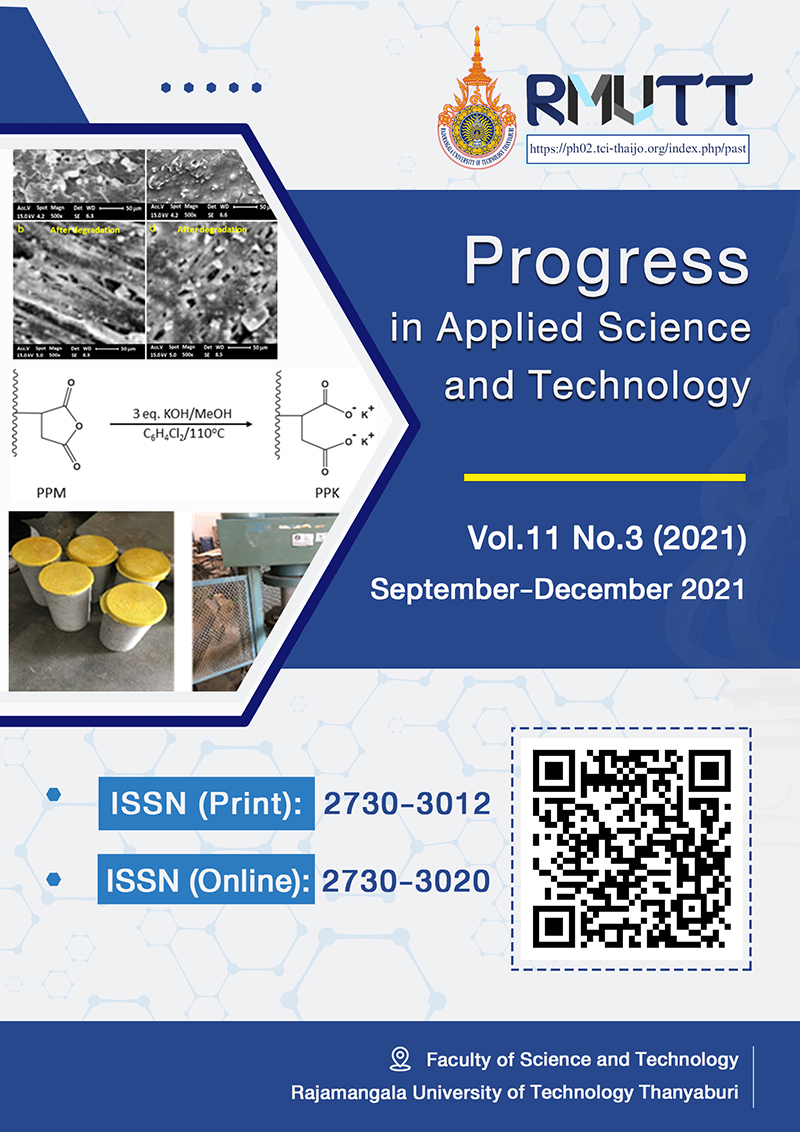Improving the Physico-mechanical and Degradable Properties of Thermoplastic Polymer with Modified Starch Blend Composites for Food packaging Applications
Main Article Content
Abstract
Plastics are an essential item of modern life and are used in many other applications such as food packaging, building components, mulching, and much more. Plastics are a subspecies of a type of material that is not degraded in the natural environment. Plastic shopping bags are manufactured from low-density polythene (LDPE) which causes ecological problems because most plastic ingredients have been in waste storage and underground for a long time. Meanwhile, several options have been considered to increase the use of biopolymers to reduce ecological problems. In this research, sago starch (SS) was treated with sodium trimetaphosphate. Sago starch was mixed with LDPE in varying levels of starch (10%-30 wt%) and the same amount of treated SS was mixed with LDPE using additives (glycerol/urea, and epolene wax) were compounded via melt mixing technique tracked by injection molded to form sheets. The reduced tensile strength percentage of the treated composite indicates that the good distribution and uniformity of SS in the LDPE was lower but more elongated at break than in the untreated composite. Treated SS composites also show less water absorption and degradation than untreated SS plastic composites. The application of the degradable composite as an eco-friendly packaging component can be effectively judged by its percentage loss in tensile strength and elongation at break by 30.7%, 44.6%, and 20.5%, 29.9% for untreated and treated composites, respectively, after 6 months of exposure to soil burial.
Article Details

This work is licensed under a Creative Commons Attribution-NonCommercial-NoDerivatives 4.0 International License.
References
Yusof Y., Kadir M. Electrochemical characterizations and the effect of glycerol in biopolymer electrolytes based on methylcellulose-potato starch blend. Molecul Cryst Liqui Cryst. 2016; 627: 220-33.
Sajjadi M., Nasrollahzadeh M., Tahsili M.R. Catalytic and antimicrobial activities of magnetic nanoparticles supported N-heterocyclic palladium (II) complex: A magnetically recyclable catalyst for the treatment of environmental contaminants in aqueous media. Separ Purif Technol. 2019; 227: 115716.
Olivera S., Muralidhara H.B., Venkatesh K., Guna V.K., Gopalakrishna K., Kumar Y. Potential applications of cellulose and chitosan nanoparticles/composites in wastewater treatment: a review. Carbohy Polym. 2016; 153: 600-18.
Bastioli C. Global status of the production of biobased packaging materials. Starch‐Stärke. 2001; 53: 351-55.
Rujnić-Sokele M., Pilipović A. Challenges and opportunities of biodegradable plastics: A mini review. Wast Manag Res. 2017; 35: 132-40.
Ju J., Xie Y., Guo Y., Cheng Y., Qian H., Yao W. Application of starch microcapsules containing essential oil in food preservation. Crit Rev Food Sci Nutri. 2020; 60: 2825-36.
Qiao D., Li S., Yu L., Zhang B., Simon G., Jiang F. Effect of alkanol surface grafting on the hydrophobicity of starch-based films. Inter J Biolog Macromol. 2018; 112: 761-66.
Abed A., Assoul N., Ba M., Derkaoui S.M., Portes P., Louedec L., et al. Influence of polysaccharide composition on the biocompatibility of pullulan/dextran‐based hydrogels. J Biomed Maters Res Part A. 2011; 96: 535-42.
Beg M.D.H., Kormin S., Bijarimi M., Zaman H.U. Environmentally degradable sago starch filled low-density polyethylene. J Polym Eng. 2015; 35: 551-63.
Ghatge S., Yang Y., Ahn J.-H., Hur H.-G. Biodegradation of polyethylene: a brief review. Appl Biolog Chem. 2020; 63: 1-14.
Peres A.M., Oréfice R.L. Effect of incorporation of Halloysite nanotubes on the structure and properties of low-density polyethylene/thermoplastic starch blend. J Polym Res. 2020; 27: 1-10.
Goheen S., Wool R. Degradation of polyethylene–starch blends in soil. J Appl Polym Sci. 1991; 42: 2691-701.
Shin M., Song J., Seib P.A. In vitro Digestibility of Cross‐Linked Starches–RS4. Starch‐Stärke. 2004; 56: 478-83.
Lee W.-J., Youn Y.-N., Yun Y.-H., Yoon S.-D. Physical properties of chemically modified starch (RS4)/PVA blend films—part 1. J Polym Envir. 2007; 15: 35-42.
Obasi H. Studies on biodegradability and mechanical properties of high density polyethylene/corncob flour based composites. International J Sci Eng Res. 2012; 3: 259-72.
Febrianto F., Setyawati D., Karina M., Bakar E.S., Hadi Y.S. Influence of wood flour and modifier contents on the physical and mechanical properties of wood flour-recycle polypropylene composites. J Biol Sci. 2006; 6: 337-43.
Wang Y.J., Liu W., Sun Z. Effects of glycerol and PE‐g‐MA on morphology, thermal and tensile properties of LDPE and rice starch blends. J Applied Polym Sci. 2004; 92: 344-50.
Danjaji I., Nawang R., Ishiaku U., Ismail H., Ishak Z.M. Degradation studies and moisture uptake of sago-starch-filled linear low-density polyethylene composites. Polym Test. 2002; 21: 75-81.
Orhan Y., Hrenović J, Büyükgüngör H. Biodegradation of plastic compost bags under controlled soil conditions. Act Chimi Sloven. 2004; 51: 579-88.






